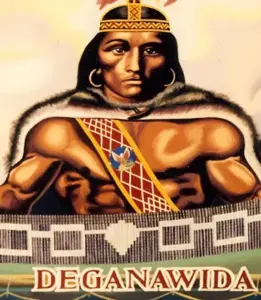The University Is Derived From Two Names
Deganawidah; the “Great Peacemaker” who helped found the Iroquois
Quetzalcoatl; an Aztec prophet who symbolizes the principles of wisdom and self-discipline
Quetzalcoatl; an Aztec prophet who symbolizes the principles of wisdom and self-discipline
Deganawida, a fascinating legend, savior and the Great Peacemaker, sometimes referred to as Tekanawi:ta was by tradition, along with Jigonhsasee and Hiawatha, the founder of the Haudenosaunee, commonly called the Iroquois Confederacy. During a time of pervasive fear and instability in the Iroquois world, a young virgin gave birth to a son. The virgin was told in a dream that “ your child will be a messenger of the Creator, and will bring peace and harmony to the people on earth.”

The Great Law
The natives had been at war for so long that someone born, knowing they had enemies, and not knowing why they had enemies. In some native cultures, they found revenge to be very attractive, some who lived only for the purpose of revenge. The natives had the capacity to make war, but did not have the capacity to make peace. A model for peacemaking and peacekeeping amongst warrior nations to heal some intergenerational wounds and to provide our children a new start.
According to Haudenosaunee stories, a male child was born, whose destiny was to address the condition of continuous warfare. The story of this man, who would come to be called the Peacemaker, gave form and substance to a kind of revolution in thinking that peace is arrived at through loving one another by the exercise of righteousness, reason, and power. You have the power to make peace with an enemy only if you acknowledge that the enemy is human. To acknowledge that they are rational beings, who want to live, and who want their children to live, enhances your power by giving you the capacity to speak to them. If you think that you are not human and you won’t have that capacity; you will have destroyed your own power to communicate with the very people you must communicate with if you’re going to bring about peace.
Deganawida’s mission was to reestablish the natural equilibrium on which the well-being of individuals, societies, and the whole of creation depends. Deganawida achieved this not as a warrior but as a healer of witches, sorcerers, and wrongdoers, by “making their minds straight.” He was explicit about this: “Health means peace, for that is what comes when minds are sane, and bodies are cared for.”
Quetzalcoatl; an Aztec prophet who symbolizes the principles of wisdom and self-discipline.
Quetzalcoatl, the legendary Toltec priest and king was reserved as the patron of priests, the inventor of the Calendar, and Books, and the protector of goldsmiths and craftsman. As the morning and evening star, he was the symbol of death and resurrection. The veneration of Quetzalcoatl rises to its greatest significance among the Toltecs of Tollan, the Divine City of the Toltec. It is said that in Tollan colored cottons flourished, huge pumpkins, cobs and cacao grew abundantly. Quetzalcoatl, was known as the wisest and fairest rulers and governed over all. He was the man-god that abolished slavery and established idol between man and the forces of nature.
In the spirit world, Quetzalcoatl plays an important role in both the creation of the universe and the invention of culture, including the discovery of agriculture, science, the arts and fire. He is frequently worshiped as the patron god of science and learning. In the spirit world, he participated in a primordial sacrifice, in which he descended into the underworld, outwitted Mictlantecuhtli, the god of the dead, and rescued mankind from the power of death. Thereafter, he ascended into heaven, where he became the evening and morning star Tlahuizcalpantecuhtli, commonly known as Venus.
Aztec legends also record the story of the semi-divine priest-king who ruled over the golden age at the paradisiacal city of Tollan. The Tollan of Quetzalcoatl is best viewed as a primordial city with a precise relationship to ordinary, secular history. Tollan was the center of ceremonial order, righteousness, abundance and wealth, social harmony, and artistic brilliance evoking cities like Atlantis. Human sacrifice was for bidden by Quetzalcoatl, who ruled with mercy and justice. He provided the prototype for subsequent leaders of the Americas, legitimizing the social, religious and political orders of kings and priests, claiming to rule after him, and by his authority. Aztec high priest themselves were called Quetzalcoatl.
Quetzalcoatl would become deceived by his brother, the demon, Tezcatlipoca into betraying his priestly vows. Tezcatlipoca used black magic to make Quetzalcoatl drink pulque and have sex with his sister, thus breaking the fragile cosmic balance. Tezcatlipoca usurped authority, demanding human sacrifice, and the golden age ended. The story has two different endings: in the first, Quetzalcoatl sacrifices himself on a funeral pyre, and ascends into heaven to become the planet or star Venus. In the second, he sells off into the sea, promising to return one day, overthrow the demon Tezcatlipoca, and restore his perfect kingdom.
The myth of the return of Quetzalcoatl played an important role in the subsequent history of the Americas. When Hernan Cortes and the conquistadors arrived in Mexico in 1517, the Aztec king Moctezuma II was convinced Hernan Cortes was Quetzalcoatl, returning as he promised to do, inviting him to assume rule of the kingdom. Spanish cruelty, and treachery, soon disabuse the Aztecs of their confusion. The conquest of Mexico was in part stimulated by the faith of the Aztecs that Quetzalcoatl would one day, return, as promised.